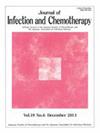The time to return-to-work in healthcare workers with COVID-19 treated with ensitrelvir, a novel oral inhibitor of 3C-like protease of SARS-CoV-2: An observational study utilizing pre-existing data from a single hospital
IF 1.5
4区 医学
Q3 INFECTIOUS DISEASES
引用次数: 0
Abstract
While treatment with anti-SARS-CoV-2 agents holds promise for managing healthcare workers with COVID-19, studies on this topic are limited. This study evaluated the time to return-to-work and remaining symptoms among healthcare workers with COVID-19 who received ensitrelvir and those who did not receive anti-SARS-CoV-2 drugs. This observational cohort study included healthcare workers diagnosed with COVID-19 between June and September 2023 at a single facility in Japan. Participants returned to work if they met all the following criteria: ≥5 days post-COVID-19 onset, fever resolution, and negative antigen test. The primary endpoint was the days from disease onset to return-to-work. We also evaluated the persistence of each symptom on the date of return-to-work, and the clinical and virological outcomes on the first scheduled date of return-to-work (Trial registration: UMIN000054128). The study enrolled 60 participants in the ensitrelvir group and 42 in the non-antiviral group. The mean number of days (SD) to return-to-work was 6.9 days (±1.6) in the ensitrelvir group and 7.7 days (±1.9) in the non-antiviral group. On the date of return-to-work, 4 participants in the non-antiviral group had taste disorders and 2 had smell disorders. On the first scheduled date of return-to-work (i.e. the date of first antigen test after onset), 56.7 % of participants in the ensitrelvir group and 33.3 % in the non-antiviral group had recovered, with the antigen test negativity in 76.7 % and 52.4 %, respectively. Ensitrelvir treatment for healthcare workers experiencing COVID-19 appeared to be associated with early symptom amelioration with viral load reduction, and shorter time to return-to-work.
接受新型口服SARS-CoV-2的3c样蛋白酶抑制剂ensitrelvir治疗的COVID-19医护人员重返工作岗位的时间:一项利用一家医院已有数据的观察性研究。
虽然使用抗 SARS-CoV-2 药物治疗有望控制 COVID-19 医护人员的病情,但这方面的研究还很有限。本研究评估了接受安赛乐和未接受抗 SARS-CoV-2 药物治疗的 COVID-19 医护人员重返工作岗位的时间和剩余症状。这项观察性队列研究纳入了 2023 年 6 月至 9 月期间在日本一家医疗机构确诊感染 COVID-19 的医护人员。如果参与者符合以下所有标准,他们就可以重返工作岗位:COVID-19发病后≥5天、退烧、抗原检测阴性。主要终点是从发病到重返工作岗位的天数。我们还评估了重返工作岗位当日每种症状的持续情况,以及首次预定重返工作岗位当日的临床和病毒学结果(试验注册号:UMIN000054128)。该研究共招募了 60 名恩替雷韦组参与者和 42 名非抗病毒组参与者。恩西特雷韦组重返工作岗位的平均天数(标度)为 6.9 天(±1.6),非抗病毒组为 7.7 天(±1.9)。在重返工作岗位之日,非抗病毒组中有 4 人出现味觉障碍,2 人出现嗅觉障碍。在首次预定的重返工作岗位日期(即发病后首次抗原检测日期),恩西特韦治疗组和非抗病毒治疗组分别有 56.7% 和 33.3% 的患者痊愈,其中分别有 76.7% 和 52.4% 的患者抗原检测呈阴性。对感染 COVID-19 的医护人员进行恩西特韦治疗似乎与早期症状改善、病毒载量降低和重返工作岗位的时间缩短有关。
本文章由计算机程序翻译,如有差异,请以英文原文为准。
求助全文
约1分钟内获得全文
求助全文
来源期刊

Journal of Infection and Chemotherapy
INFECTIOUS DISEASES-PHARMACOLOGY & PHARMACY
CiteScore
4.10
自引率
4.50%
发文量
303
审稿时长
47 days
期刊介绍:
The Journal of Infection and Chemotherapy (JIC) — official journal of the Japanese Society of Chemotherapy and The Japanese Association for Infectious Diseases — welcomes original papers, laboratory or clinical, as well as case reports, notes, committee reports, surveillance and guidelines from all parts of the world on all aspects of chemotherapy, covering the pathogenesis, diagnosis, treatment, and control of infection, including treatment with anticancer drugs. Experimental studies on animal models and pharmacokinetics, and reports on epidemiology and clinical trials are particularly welcome.
 求助内容:
求助内容: 应助结果提醒方式:
应助结果提醒方式:


